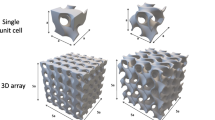Abstract
The finite volume model is developed for multi-pass grinding by considering the grinding wheel and work contact zone as a rectangular shaped moving heat source with uniform heat distribution at a velocity equal to the feed rate. Though some literature dealt the thermal modelling of single pass grinding, in practical application multi-pass grinding is done in most of the industries to enhance the finish of work material. Modelling the temperature profile in multi-pass grinding is complex due to the heat from previous passes is carried out to the next pass. This heat accumulation from previous passes increase the peak flash temperature. Hence there is an urge to develop a thermal model which calculates the depth of heat affected zone for multi-pass grinding. The experimentally obtained grinding power is used in calculating the heat flux which replicates the condition of abrasive grains, work-wheel interaction and process behavior. For experimental validation, thermocouple is placed at a depth of 1.5mm below the grinding surface and temperature values are obtained as the material is ground till the wheel touches the thermocouple. The temperature distribution for multiple grinding passes on the work material at different depths and time, Peak temperature and the heat flux distribution.
Similar content being viewed by others
References
Subramanian, K. and Lindsay, R. P., “A Systems Approach for the Use of Vitrified Bonded Superabrasive Wheels for Precision Production Grinding,” Journal of Engineering for Industry, Vol. 114, No. 1, pp. 41–52, 1992.
Malkin, S. and Guo, C., “Grinding Technology: Theory and Applications of Machining with Abrasives,” Industrial Press Inc., 2008.
Rowe, W. B. and Jin, T., “Temperatures in High Efficiency Deep Grinding (HEDG),” CIRP Annals-Manufacturing Technology, Vol. 50, No. 1, pp. 205–208, 2001.
Lefebvre, A., Lanzetta, F., Lipinski, P., and Torrance, A. A., “Measurement of Grinding Temperatures using a Foil/Workpiece Thermocouple,” International Journal of Machine Tools and Manufacture, Vol. 58, pp. 1–10, 2012.
Jaeger, J. C., “Moving Sources of Heat and the Temperature at Sliding Contacts,” Journal and proceedings of the Royal Society of New South Wales, Vol. 76, pp. 203–224, 1942.
Jin, T. and Cai, G. Q., “Analytical Thermal Models of Oblique Moving Heat Source for Deep Grinding and Cutting,” Journal of Manufacturing Science and Engineering, Vol. 123, No. 2, pp. 185–190, 2001.
Fang, C. and Xu, X., “Analysis of Temperature Distributions in Surface Grinding with Intermittent Wheels,” The International Journal of Advanced Manufacturing Technology, Vol. 71, Nos. 1-4, pp. 23–31, 2014.
Skuratov, D. L., Ratis, Yu. L., Selezneva, I. A., Pérez, J., de Córdoba, P. F., and Urchueguía, J. F., “Mathematical Modelling and Analytical Solution for Workpiece Temperature in Grinding,” Applied Mathematical Modelling, Vol. 31, No. 6, pp. 1039–1047, 2007.
Gu, R. J., Shillor, M., Barber, G. C., and Jen, T., “Thermal Analysis of the Grinding Process,” Mathematical and Computer Modelling, Vol. 39, Nos. 9-10, pp. 991–1003, 2004.
Sharma, C., Ghosh, S., and Talukdar, P., “Finite Element Analysis of Workpiece Temperature during Surface Grinding of Inconel 718 Alloy,” Proc. of 5th International and 26th All India Manufacturing Technology, Design and Research Conference, 2014.
Shen, B., Shih, A. J., and Xiao, G., “A Heat Transfer Model Based on Finite Difference Method for Grinding,” Journal of Manufacturing Science and Engineering, Vol. 133, No. 3, Paper No. 031001, 2011.
Chuang, T.-J., Jahanmir, S., and Tang, H. C., “Finite Element Simulation of Straight Plunge Grinding for Advanced Ceramics,” Journal of the European Ceramic Society, Vol. 23, No. 10, pp. 1723–1733, 2003.
Mamalis, A. G., Kunádrk, J., Manolakos, D., Gyáni, K., and Markopoulos, A., “Thermal Modelling of Surface Grinding Using Implicit Finite Element Techniques,” The International Journal of Advanced Manufacturing Technology, Vol. 21, No. 12, pp. 929–934, 2003.
Jin, T. and Stephenson, D. J., “Three Dimensional Finite Element Simulation of Transient Heat Transfer in High Efficiency Deep Grinding,” CIRP Annals-Manufacturing Technology, Vol. 53, No. 1, pp. 259–262, 2004.
Andrews, K. T., Shillor, M., and Wright, S., “A Model for Heat Transfer in Grinding,” Nonlinear Analysis: Theory, Methods & Applications, Vol. 35, No. 2, pp. 233–246, 1999.
Gu, R. J., Shillor, M., Barber, G. C., and Jen, T., “Thermal Analysis of the Grinding Process,” Mathematical and Computer Modelling, Vol. 39, Nos. 9-10, pp. 991–1003, 2004.
Mahdi, M. and Zhang, L., “The Finite Element Thermal Analysis of Grinding Processes by ADINA,” Computers & Structures, Vol. 56, Nos. 2-3, pp. 313–320, 1995.
Rowe, W. B., “Principles of Modern Grinding Technology,” William Andrew, 2013.
Lao, Y., Du, H., Xiong, T., and Wang, Y., “Evolution Behaviors of Oxides in Severely Plastic Deformed Region of AISI 52100 Steel during Dry Sliding Wear,” Journal of Materials Science & Technology, Vol. 33, No. 4, pp. 330–337, 2017.
Das, D., Dutta, A. K., and Ray, K. K., “Influence of Varied Cryotreatment on the Wear Behavior of AISI D2 Steel,” Wear, Vol. 266, No. 1, pp. 297–309, 2009.
Madopothula, U., Lakshmanan, V., and Nimmagadda, R. B., “Time Dependent Behavior of Alumina Grains Manufactured by Two Different Routes While Grinding of AISI 52100 Steels,” Archives of Civil and Mechanical Engineering, Vol. 17, No. 2, pp. 400–409, 2017.
Shen, B., Xiao, G., Guo, C., Malkin, S., and Shih, A. J., “Thermocouple Fixation Method for Grinding Temperature Measurement,” Journal of Manufacturing Science and Engineering, Vol. 130, No. 5, pp. 1–8, 2008.
Author information
Authors and Affiliations
Corresponding author
Rights and permissions
About this article
Cite this article
Madopothula, U., Lakshmanan, V., Nimmagadda, R.B. et al. Prediction of temperature distribution in the workpiece during multi-pass grinding by finite volume method. Int. J. Precis. Eng. Manuf. 18, 1485–1493 (2017). https://doi.org/10.1007/s12541-017-0176-3
Received:
Revised:
Accepted:
Published:
Issue Date:
DOI: https://doi.org/10.1007/s12541-017-0176-3




